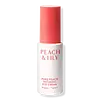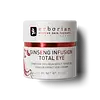What's inside
What's inside
 Key Ingredients
Key Ingredients

 Benefits
Benefits

 Concerns
Concerns

 Ingredients Side-by-side
Ingredients Side-by-side

Water
Skin ConditioningCetyl Ethylhexanoate
EmollientPropanediol
SolventButylene Glycol
Humectant1,2-Hexanediol
Skin ConditioningGlycerin
HumectantNiacinamide
SmoothingCetearyl Alcohol
EmollientSodium Hyaluronate
HumectantSodium Acetylated Hyaluronate
HumectantHydrolyzed Hyaluronic Acid
HumectantBambusa Textilis Stem Extract
Skin ConditioningArctium Lappa Root Extract
Skin ConditioningMorus Alba Leaf Extract
Skin ConditioningPrunus Persica Fruit Extract
AbrasiveBakuchiol
AntimicrobialRosa Rubiginosa Seed Oil
EmollientDaucus Carota Sativa Root Water
MaskingBrassica Oleracea Italica Extract
AstringentPanax Ginseng Root Extract
EmollientSpinacia Oleracea Leaf Extract
Skin ConditioningAloe Barbadensis Leaf Extract
EmollientAcetyl Octapeptide-3
HumectantCamellia Sinensis Leaf Extract
AntimicrobialCucumis Sativus Extract
Skin ConditioningApium Graveolens Extract
Skin ConditioningMelia Azadirachta Leaf Extract
Skin ConditioningCaprylyl Glycol
EmollientSorbitan Olivate
EmulsifyingLactuca Scariola Sativa Leaf Extract
Skin ConditioningCeramide NP
Skin ConditioningCoccinia Indica Fruit Extract
Skin ConditioningMelia Azadirachta Flower Extract
Skin ConditioningTocopheryl Acetate
AntioxidantFerulic Acid
AntimicrobialTocopherol
AntioxidantPanthenol
Skin ConditioningCaprylic/Capric Triglyceride
MaskingMangifera Indica Seed Butter
Skin ConditioningAdenosine
Skin ConditioningCetearyl Olivate
Hydrogenated Rapeseed Alcohol
EmollientBetaine
HumectantAcrylates/C10-30 Alkyl Acrylate Crosspolymer
Emulsion StabilisingTromethamine
BufferingEthylhexylglycerin
Skin ConditioningPolyglyceryl-4 Oleate
EmulsifyingGlyceryl Olivate
EmollientGlyceryl Stearate
EmollientPropylene Glycol
HumectantAsparagus Officinalis Extract
Skin ConditioningHydrogenated Lecithin
EmulsifyingPhosphoric Acid
BufferingCorallina Officinalis Extract
Skin ConditioningWater, Cetyl Ethylhexanoate, Propanediol, Butylene Glycol, 1,2-Hexanediol, Glycerin, Niacinamide, Cetearyl Alcohol, Sodium Hyaluronate, Sodium Acetylated Hyaluronate, Hydrolyzed Hyaluronic Acid, Bambusa Textilis Stem Extract, Arctium Lappa Root Extract, Morus Alba Leaf Extract, Prunus Persica Fruit Extract, Bakuchiol, Rosa Rubiginosa Seed Oil, Daucus Carota Sativa Root Water, Brassica Oleracea Italica Extract, Panax Ginseng Root Extract, Spinacia Oleracea Leaf Extract, Aloe Barbadensis Leaf Extract, Acetyl Octapeptide-3, Camellia Sinensis Leaf Extract, Cucumis Sativus Extract, Apium Graveolens Extract, Melia Azadirachta Leaf Extract, Caprylyl Glycol, Sorbitan Olivate, Lactuca Scariola Sativa Leaf Extract, Ceramide NP, Coccinia Indica Fruit Extract, Melia Azadirachta Flower Extract, Tocopheryl Acetate, Ferulic Acid, Tocopherol, Panthenol, Caprylic/Capric Triglyceride, Mangifera Indica Seed Butter, Adenosine, Cetearyl Olivate, Hydrogenated Rapeseed Alcohol, Betaine, Acrylates/C10-30 Alkyl Acrylate Crosspolymer, Tromethamine, Ethylhexylglycerin, Polyglyceryl-4 Oleate, Glyceryl Olivate, Glyceryl Stearate, Propylene Glycol, Asparagus Officinalis Extract, Hydrogenated Lecithin, Phosphoric Acid, Corallina Officinalis Extract
Water
Skin ConditioningButylene Glycol
HumectantCyclomethicone
EmollientButyrospermum Parkii Butter
Skin ConditioningOctyldodecanol
EmollientCetearyl Alcohol
EmollientPalmitic Acid
EmollientTalc
AbrasivePanax Ginseng Root Extract
EmollientCentella Asiatica Extract
CleansingScutellaria Baicalensis Root Extract
AstringentPolygonum Cuspidatum Root Extract
AntioxidantGlycyrrhiza Glabra Root Extract
BleachingCamellia Sinensis Leaf Extract
AntimicrobialRosmarinus Officinalis Leaf Extract
AntimicrobialSaccharomyces Cerevisiae Extract
Skin ConditioningChamomilla Recutita Flower Extract
MaskingDioscorea Villosa Root Extract
Skin ConditioningEquisetum Giganteum Extract
Skin ConditioningKigelia Africana Fruit Extract
Skin ConditioningPrunus Amygdalus Dulcis Oil
Skin ConditioningHydrogenated Vegetable Oil
EmollientGlycine Soja Oil
EmollientSesamum Indicum Seed Oil
EmollientZea Mays Oil
EmulsifyingVegetable Oil
Skin ConditioningEthylhexylglycerin
Skin ConditioningTocopherol
AntioxidantTocopheryl Acetate
AntioxidantPanthenol
Skin ConditioningMannitol
HumectantArginine
MaskingStearyl Stearate
EmollientStearic Acid
CleansingGlyceryl Stearate
EmollientPEG-100 Stearate
Ozokerite
Emulsion StabilisingCera Alba
EmollientHydrogenated Palm Acid
Cellulose
AbsorbentHydroxypropyl Methylcellulose
Emulsion StabilisingAmmonium Acryloyldimethyltaurate/Vp Copolymer
Mica
Cosmetic ColorantPhenoxyethanol
PreservativeT-Butyl Alcohol
PerfumingCI 77891
Cosmetic ColorantCI 77492
Cosmetic ColorantWater, Butylene Glycol, Cyclomethicone, Butyrospermum Parkii Butter, Octyldodecanol, Cetearyl Alcohol, Palmitic Acid, Talc, Panax Ginseng Root Extract, Centella Asiatica Extract, Scutellaria Baicalensis Root Extract, Polygonum Cuspidatum Root Extract, Glycyrrhiza Glabra Root Extract, Camellia Sinensis Leaf Extract, Rosmarinus Officinalis Leaf Extract, Saccharomyces Cerevisiae Extract, Chamomilla Recutita Flower Extract, Dioscorea Villosa Root Extract, Equisetum Giganteum Extract, Kigelia Africana Fruit Extract, Prunus Amygdalus Dulcis Oil, Hydrogenated Vegetable Oil, Glycine Soja Oil, Sesamum Indicum Seed Oil, Zea Mays Oil, Vegetable Oil, Ethylhexylglycerin, Tocopherol, Tocopheryl Acetate, Panthenol, Mannitol, Arginine, Stearyl Stearate, Stearic Acid, Glyceryl Stearate, PEG-100 Stearate, Ozokerite, Cera Alba, Hydrogenated Palm Acid, Cellulose, Hydroxypropyl Methylcellulose, Ammonium Acryloyldimethyltaurate/Vp Copolymer, Mica, Phenoxyethanol, T-Butyl Alcohol, CI 77891, CI 77492
Ingredients Explained
These ingredients are found in both products.
Ingredients higher up in an ingredient list are typically present in a larger amount.
Butylene Glycol (or BG) is used within cosmetic products for a few different reasons:
Overall, Butylene Glycol is a safe and well-rounded ingredient that works well with other ingredients.
Though this ingredient works well with most skin types, some people with sensitive skin may experience a reaction such as allergic rashes, closed comedones, or itchiness.
Learn more about Butylene GlycolCamellia Sinensis Leaf Extract is derived from the leaves of the tea plant. Black tea, green tea, and oolong tea are all harvested from this plant.
This ingredient has many skin benefits:
This ingredient contains polyphenols, a strong antioxidant. Antioxidants help fight off molecules that damage skin cells.
On top of that, the antioxidants in green tea neutralize free-radicals from the sun. This gives the skin some extra UV protection, but should not replace sunscreen.
Many components of tea have anti-inflammatory properties.
Polyphenols and L-theanine help soothe the skin and reduce irritation. The caffeine in Camellia Sinensis Leaf Extract helps calm inflamed blood vessels.
Other compounds found in tea include: Vitamin Bs, linoleic acid, magnesium, calcium, iron, and zinc.
Research has shown both drinking Camellia Sinensis Leaf Tea and applying it to the skin can help boost skin elasticity and hydration. Studies also show using tea extract may reduce sebum, or oil, production.
Learn more about Camellia Sinensis Leaf ExtractCetearyl alcohol is a mixture of two fatty alcohols: cetyl alcohol and stearyl alcohol. It is mainly used as an emulsifier. Emulsifiers help prevent the separation of oils and products. Due to its composition, it can also be used to thicken a product or help create foam.
Cetearyl alcohol is an emollient. Emollients help soothe and hydrate the skin by trapping moisture.
Studies show Cetearyl alcohol is non-toxic and non-irritating. The FDA allows products labeled "alcohol-free" to have fatty alcohols.
This ingredient is usually derived from plant oils such as palm, vegetable, or coconut oils. There is debate on whether this ingredient will cause acne.
Due to the fatty acid base, this ingredient may not be Malassezia folliculitis safe.
Learn more about Cetearyl AlcoholEthylhexylglycerin (we can't pronounce this either) is commonly used as a preservative and skin softener. It is derived from glyceryl.
You might see Ethylhexylglycerin often paired with other preservatives such as phenoxyethanol. Ethylhexylglycerin has been found to increase the effectiveness of these other preservatives.
Glyceryl Stearate is a mix of glycerin and stearic acid.
It is used to stabilize the mixing of water and oil ingredients. By preventing these ingredients from separating, it can help elongate shelf life. It can also help thicken the product's texture.
As an emollient, it helps soften skin and supports barrier-replenishing ingredients.
In cosmetics, Glyceryl Stearate is often made from vegetable oils or synthetically produced.
This ingredient may not be fungal-acne safe
Fun fact: The human body also creates Glyceryl Stearate naturally.
Learn more about Glyceryl StearateGinseng root is a well-loved ingredient in Asian skincare for good reason. It hydrates the skin, soothes irritation, and helps even out skin tone.
In traditional East Asian medicine, ginseng has been used for centuries both as food and as a healing remedy, and modern research continues to confirm its skin benefits.
One of the standout features of ginseng is its ability to improve blood circulation and oxygen delivery to the skin, bringing a fresh supply of nutrients to support overall skin health. It also has antioxidant and anti-inflammatory properties. This helps to protect your skin against damage from UV exposure, pollution, and daily stress.
Additionally, studies suggest that ginseng may help reduce hyperpigmentation by inhibiting tyrosinase, the enzyme involved in melanin production.
There are different types of ginseng used in skincare, and while they all share core benefits, their potency can vary.
Most products use fresh or white ginseng because it’s more affordable. However, red ginseng, produced by steaming the root, contains higher levels of ginsenosides, which are compounds with proven anti-aging effects. These ginsenosides help reduce the appearance of wrinkles and improve skin elasticity.
Note: All forms of ginseng are listed simply as “Panax ginseng” in ingredient lists. We recommend reaching out to the brand if you have questions about which type of ginseng is used in their ingredients.
For general antioxidant benefits, any ginseng extract will do, but for wrinkle care or firmer skin, red or fermented ginseng is often more effective.
In short, ginseng is a powerhouse ingredient that supports hydration, radiance, and resilience.
Learn more about Panax Ginseng Root ExtractPanthenol is a common ingredient that helps hydrate and soothe the skin. It is found naturally in our skin and hair.
There are two forms of panthenol: D and L.
D-panthenol is also known as dexpanthenol. Most cosmetics use dexpanthenol or a mixture of D and L-panthenol.
Panthenol is famous due to its ability to go deeper into the skin's layers. Using this ingredient has numerous pros (and no cons):
Like hyaluronic acid, panthenol is a humectant. Humectants are able to bind and hold large amounts of water to keep skin hydrated.
This ingredient works well for wound healing. It works by increasing tissue in the wound and helps close open wounds.
Once oxidized, panthenol converts to pantothenic acid. Panthothenic acid is found in all living cells.
This ingredient is also referred to as pro-vitamin B5.
Learn more about PanthenolTocopherol (also known as Vitamin E) is a common antioxidant used to help protect the skin from free-radicals and strengthen the skin barrier. It's also fat soluble - this means our skin is great at absorbing it.
Vitamin E also helps keep your natural skin lipids healthy. Your lipid skin barrier naturally consists of lipids, ceramides, and fatty acids. Vitamin E offers extra protection for your skin’s lipid barrier, keeping your skin healthy and nourished.
Another benefit is a bit of UV protection. Vitamin E helps reduce the damage caused by UVB rays. (It should not replace your sunscreen). Combining it with Vitamin C can decrease sunburned cells and hyperpigmentation after UV exposure.
You might have noticed Vitamin E + C often paired together. This is because it is great at stabilizing Vitamin C. Using the two together helps increase the effectiveness of both ingredients.
There are often claims that Vitamin E can reduce/prevent scarring, but these claims haven't been confirmed by scientific research.
Learn more about TocopherolTocopheryl Acetate is AKA Vitamin E. It is an antioxidant and protects your skin from free radicals. Free radicals damage the skin by breaking down collagen.
One study found using Tocopheryl Acetate with Vitamin C decreased the number of sunburned cells.
Tocopheryl Acetate is commonly found in both skincare and dietary supplements.
Learn more about Tocopheryl AcetateWater. It's the most common cosmetic ingredient of all. You'll usually see it at the top of ingredient lists, meaning that it makes up the largest part of the product.
So why is it so popular? Water most often acts as a solvent - this means that it helps dissolve other ingredients into the formulation.
You'll also recognize water as that liquid we all need to stay alive. If you see this, drink a glass of water. Stay hydrated!
Learn more about Water